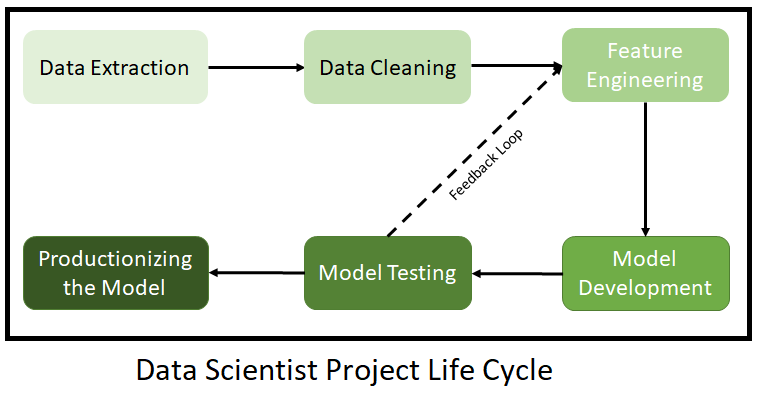Track

The advent of the internet and the increasing use of technology has resulted in an exponential increase in data volumes. The increase in businesses’ reliance on data-driven decision making has left them vying for the best talent pool to efficiently source data from relevant and reliable sources, store it, and use it for their businesses.
As businesses continue to make huge investments in not just setting up their data infrastructure, but also in acquiring the right talent pool, the roles of data analyst and data scientist have emerged as the two most popular roles. Their popularity stems from the burgeoning demand for these data specialists across almost every industry.
Understanding the Differences Between Data Analysts and Data Scientists
The distinction between a data analyst and a data scientist stems from the nature of the work they perform. For a data analyst, the profile is primarily exploratory in contrast to an experimental work profile of a data scientist.
The distinction between a data analyst and a data scientist stems from the level of expertise in data usage. Of the two, a data scientist should be more hands-on with advanced programming techniques and computing tools. Also, a data scientist should be more adept at developing data models and algorithms. Understanding the different ways in which businesses use data can further help bring more clarity to their respective roles.
- Descriptive Analytics: Analytical solutions in this category answer the What and Why part of the business problems. They provide actionable insights by understanding historical data patterns, trends, and anomalies. For example, identifying the change in customer engagement over the years and the reasons behind the same can be solved using descriptive analytics.
- Predictive Analytics: As the name suggests, this category of solutions employs machine learning models to estimate the future using past data trends. For example, calculating the probability of cross-selling a product to the customer based on their historical engagement is done using predictive analytics.
- Prescriptive Analytics: Prescriptive analytics uses the outcomes of descriptive and predictive analytics to formulate improved business strategies. Again, using the historical engagement and the probability of cross-selling, the business can identify the best product mix for the customers.
A data analyst employs descriptive analytics to report facts and sometimes provides prescriptive analytics by way of recommendations based on these insights. A data scientist covers the entire range of the analytics journey, focusing primarily on predictive analytics and generating value for organizations with data.
Data Analyst vs. Data Scientist: A Comparison of Their Roles and Responsibilities
A data analyst may perhaps have many other job titles, such as a strategist, a business intelligence analyst, a market intelligence analyst or a consultant, or a competitive intelligence analyst. Whatever the exact job title is, a data analyst is usually expected to provide insights by querying volumes of data (mostly structured) and then converting them into meaningful reports for various stakeholders. Hence, the role is more about finding patterns in data, generating data visualizations, and communicating the insights to business stakeholders. Find out more about how to become a data analyst or how to become a data scientist in our dedicated articles.
In contrast, a data scientist performs tasks falling in the realm of predictive and prescriptive analytics. For example, taking the example of a ride-hailing software service, a data analyst would analyze the historical impact a promotion had on the ride-hailing activity. On the other hand, a data scientist might work on a matching algorithm that most efficiently matches drivers to riders.
Project Life Cycle of a Data Analyst and a Data Scientist
Data Analyst
Detailed below is how the lifecycle of a project handled by a data analyst typically looks.

- Data extraction: Data extraction is limited to smaller datasets since data analysts primarily look at specific business scenarios.
- Data cleaning and preparation: Once extracted, the data is processed and summarized in the form of visualizations that can intuitively highlight underlying facts, emerging trends, and anomalies.
- Data exploration: During this activity, the analyst starts exploring the reasons behind the various trends and anomalies observed during the data preparation stage.
- Data visualization and reporting: Next, the analyst prepares intuitive dashboards and management reports comprising business commentaries and shares them with the end stakeholders. Commonly, several self-serving business intelligence tools such as Tableau and Power BI are used for this purpose.
Data Scientist
The process flow chart shown below details the various stages in the project handled by a data scientist.

- Data extraction: This is a common step for both data analysts as well as data scientists. However, the data source for data scientists is not just restricted to a set of small tables but is mostly vast. In such cases, a data scientist and a data engineer work together.
- Data cleaning: During this stage, the data scientist spends a considerable amount of time developing an in-depth view of the data, understanding underlying issues, identifying anomalies, and finally cleaning it up for further stages.
- Feature engineering: Before data scientists start working on predictive models, they undertake feature engineering. Feature engineering is the process of using cleaned data to create variables expected to have a better predictive power on the target outcome. For example, for building a predictive model to predict the likelihood of an individual getting diabetes, BMI may also be used as an additional input to the model besides height and weight. Here, BMI is an engineered feature calculated using height and weight.
- Model development using AI/ML techniques: The data is then fed to a machine-learning algorithm to produce predictions. There is a wide range of machine learning algorithms with varying degrees of complexity and use cases. Read this guide for the distinctions between different types of machine learning algorithms.
- Model testing: During this stage, a data scientist validates model outputs. For unsatisfactory results, the scientist revisits the model parameters and tunes them to achieve the desired result. However, if the model tuning fails, the data scientist goes back to the drawing board and looks at re-designing the feature to support subsequent model builds.
- Productionalizing the model: Post model development and model tuning, both software engineering and data engineering teams collaborate to create production-ready model pipelines. This enables seamless integration with the data pipeline. As a final step, they work on formalizing and deploying the code into the production environment.
Now that we have a view on the roles and responsibilities of data analysts and data scientists, the question that follows is which skills will best prepare you for undertaking either of these roles? Here’s a comparative guide on the skill requirements for these roles.
Data Analyst vs. Data Scientist: Skill Comparison
The skill requirements for both roles are very similar. However, the level of proficiency in every skill varies greatly. The table below lists the eight key skills and the level of proficiency in them expected from a data analyst and a data scientist:
| Area of Skill | Data Analyst | Data Scientist |
|---|---|---|
| Data Engineering | Low | Medium |
| Data Exploration | High | High |
| Data Visualization | High | Medium |
| Tools and Programming Languages | Medium | High |
| Data Modeling & Algorithms | Low | High |
| Business Domain Knowledge | High | High |
| Software Engineering | Low | Medium |
| Communication & Presentation | High | High |
| Statistical Analysis | Medium | High |
| Machine Learning | Low | High |
| Big Data Technologies | Low | Medium |
| Data Governance and Compliance | Medium | Medium |
| Project Management | Medium | Low |
| Research & Development | Low | High |
| Data Quality Management | High | Medium |
| Cross-functional Collaboration | High | High |
| Cloud Computing Skills | Low | Medium |
| Data Security and Privacy | Medium | High |
Data Analyst
A project life cycle for a data analyst typically has two stages: Insight generation and insight communication. Let’s understand the skill requirements for each of these stages:
- Insight generation: To generate actionable and impactful insights, data analysts should have adequate domain knowledge to explore data effectively. Inadequate expertise in either would imply an improper understanding of business problems and can potentially give misleading results. Given the modern-day technology landscape in organizations, exploratory analysis demands that analysts are proficient in programming languages like SQL, Python, and R. They should be able to write codes efficiently within the paradigm of functional programming. Hence, working knowledge of these languages to at least better perform any data-wrangling operations should suffice. Proficiency in data engineering can significantly help data analysts reduce their dependence on data teams. This can be a big plus for them.
- Insight communication: Being able to communicate and present insights effectively to senior stakeholders is an important skill. To be effective, a good grasp of data visualization tools like Tableau and Power BI can come in handy for a data analyst. As insight communication is done usually through presentations and dashboards, a data analyst is rarely required to productionalize the codes. Therefore, knowledge of software engineering aspects generally takes a back seat.
Data Scientist
Though the business problems handled by data scientists seem varied, the projects they manage by and large involve building predictive models and productionalizing them. The skills required to perform these activities are as follows:
- Predictive modeling: Besides being adept at data exploration and business domain knowledge, a data scientist should also have a good command of various data modeling techniques and associated algorithms. High proficiency in open source languages like Python and R is therefore necessary. Using visualization tools is a prerequisite for them to share modeling outcomes with various stakeholders. Besides this, a data scientist needs to extract data at will and effectively communicate data pipeline requirements to the engineering team. Therefore, having skills in the data engineering domain are a must-have for a data scientist.
- Model productionalization: Generally, the output from the data models is fed into a front-end system accessible to the front-line users. To ensure seamless integration, a data scientist is expected to develop Restful APIs, JSON feeds, and other web services. All codes written by a data scientist during the model and API development are required to be production-ready. Working knowledge of software engineering is thus needed to support an understanding of object-oriented programming.
Data Analyst vs. Data Scientist: Educational Backgrounds
This section will give you a high-level view of the educational qualifications a data analyst and a data scientist usually have, their areas of study, and some key emerging trends.
A comparison of educational qualifications
According to Burtch Works Study 2023, the level of education of a data analyst and a data scientist bears a significant impact on their salaries, a finding that will get corroborated in the subsequent section on industry outlook for the two roles.
|
A Look at Educational Qualifications |
|
|
Degree Level Comparison |
Data Scientist |
|
Bachelor's |
31% |
|
Master's |
57% |
|
PhD |
12% |
Source: Burtch Works Study 2023
In 2021, of the total number of data scientists surveyed, 49% held a Ph.D. However, only 19% of data analysts surveyed held a Ph.D.
|
A Comparison of Area of Study |
||
|
Area of Study |
Data Analyst |
Data Scientist |
|
Mathematics/Statistics |
37% |
21% |
|
Business |
21% |
8% |
|
Engineering |
14% |
19% |
|
Economics |
9% |
6% |
|
Computer Science |
8% |
24% |
|
Natural Science |
5% |
21% |
|
Social Science |
5% |
1% |
Source: Burtch Works Study 2021
While computer science emerged as the most popular area of study for data scientists, engineering is gradually picking up pace in its popularity amongst the two roles.
Key Trends
According to the research of Burtch Works Study 2021, the key demographic trends that have emerged for data science and analytics are:
- The number of professionals with Ph.D.s has shown a significant increase compared to previous years where the numbers have shown an affinity toward bachelor’s or master’s programs. For example, in the sample study of data scientists, those with Ph.D.s increased from 43% in 2020 to 48% in 2021.
- Many experienced analytics professionals with Ph.D.s and academic professionals willing to take up corporate roles are emerging as the new favorites for data science positions capable of converting their extensive research into business applications.
- The traditional MBA programs in data science and analytics have given way to programs such as an MS in Business Analytics or MS in Data Science as they have a much higher quantitative focus. Among data scientists, business degrees fell from 12% in 2019 to 8% in 2021
As students and professionals gravitate toward taking up various advanced courses to upskill and re-train themselves, online courses are a great offering that can bundle professional certifications outside the traditional setting of a university.
Data Analytics and Data Science Courses
Given the clear distinction in the roles and responsibilities of a data analyst and a data scientist, DataCamp offers career tracks for both of these roles that meet their specific skill requirements.
Data Analyst Career Tracks
Data Analyst with Python (Course content: 62 hours)
This track starts with the basics of the Python programming language for data analysis. After covering the basics, this track dives deeper into data wrangling and data visualization techniques. Also learn to source data from different sources such as the web, databases, and JSON files. In addition, this track provides an overview of exploratory data analysis techniques and upskills the learner on concepts of relational databases and SQL.
Data Analyst with R (Course content: 77 hours)
This track focuses on the primary skills required by data analysts working with the R programming language. It offers comprehensive content covering the most commonly used R packages like tidyverse, ggplot, and dplyr. Similar to the Python track, the course helps build an intermediate understanding of data analyst skills such as data sourcing, manipulation, and visualization.
Data Analyst with SQL (Course content: 41 hours)
This career track helps the learner develop an in-depth understanding of SQL Server, the concepts of relational databases, their design, and performance optimization.
Data Scientist Career Tracks
Career tracks for data scientists are available in Python and R. They help the learner deep-dive into the software engineering aspects of Python like object-oriented programming. They also give an overview of statistics and supervised and unsupervised machine learning techniques. The tracks also offer case studies at every milestone to give learners practical exposure to real-life problems.
Data Scientist with Python (Course content: 88 hours)
This course takes the learner on a journey from a beginner to an expert data scientist. Besides introducing Python for data sourcing, data manipulation, and data visualization, it also gives learners an overview of functional and object-oriented programming paradigms. The course provides an in-depth understanding of machine learning algorithms across supervised, unsupervised, and clustering categories. In addition to learning data science concepts, the learner also gets exposure to real-life project challenges through relevant case studies.
Data Scientist with R (Course content: 88 hours)
For data scientists working with the R programming language, this career track delves deep into R and introduces the functional programming approach to the learners. This course also includes an in-depth introduction to machine learning algorithms like regression, classification, and clustering, to name a few.
Professional Certification Programs
The following certifications help bridge the data skill gap that exists in the job market. They ensures that the right skill meets the right opportunity as the learners can showcase their skills while the employer gains confidence in hiring the right talent. The programs validate the learner’s ability in several key areas, including data management, exploratory analysis, statistical experimentation, model development, coding for production environments, and communication and reporting. Expert feedback and mentoring sessions also help the learner acquire the confidence for being job-ready. DataCamp offers two certifications, one for data scientists and one of data analysts.
The DataCamp professional data scientist certification has four stages:
- Timed Assessments: The learner's proficiency in topics such as programming and machine learning is determined.
- Coding Challenge: The learner's R or Python coding skills are challenged using real-world datasets.
- Case Study: Learners will present their findings just as they would in their day-to-day jobs as data scientists.
- Certification: On completing the three stages mentioned above, the learner will receive a certificate and access to the Career Services team.
The DataCamp professional data analyst certification has five stages:
- Fundamentals in Data Analytics: During this section, you'll be tested on your understanding of core analytic approaches expected of a Professional Data Analyst.
- Exploratory Analysis: Approach a problem, find the right data, and effectively format it through a coding challenge in SQL and Python or R.
- Coding Challenge: Prove your abilities to clean and process data through a hands-on SQL challenge.
- Case Study: Test your ability to analyze and communicate data insights through conducting a recorded case study with our certification team. Here you'll need to analyze a business problem and then present your solution to a defined audience.
- Certification: On completing the four stages mentioned above, the learner will receive a certificate and access to the Career Services team.
Learn more about DataCamp’s certification programs here:
DataCamp’s Data Scientist Certification Programs
DataCamp's Data Analyst Certification Program
Data Analyst vs. Data Scientist: Industry Outlook
The Burtch Works Study from 2021 reviews the salaries of data science and data analytics professionals. This study indicates that the hiring landscape for data science and analytics teams looks promising. The study reports that 73% of data science and analytics teams planned to hire in Q1/Q2 of 2021 compared to 67% in January 2020. Moreover, around 81% of data science and analytics teams plan to recruit in Q3/Q4 of 2021. This is a significant increase compared to the numbers for the first half of 2021.
The table below summarizes the salary trends for a data analyst and a data scientist by level. These trends are for both the role of an individual contributor and a manager. These levels also give a high-level overview of how the career paths of a data analyst and a data scientist can evolve.
|
Median Salary Comparison of Individual Contributors (IC) |
|||||
|
Median Salaries (USD) 2021 |
|||||
|
IC Levels |
Data Analyst |
Data Scientist |
Job Responsibility |
Avg. Years of Exp. |
|
|
Level 1 |
80,000 |
95,000 |
Beginner stage and hands-on with analytics & modeling |
0-3 years |
|
|
Level 2 |
103,500 |
130,000 |
Intermediate level of expertise, hands-on, can assist in training analysts |
4-8 years |
|
|
Level 3 |
135,000 |
160,000 |
Subject Matter Expert, can take up mentorship roles and can independently train analysts |
9+ years |
|
Source: The Burtch Works Study 2021
|
Median Salary Comparison of Managers |
||||
|
Median Salaries (USD) 2021 |
||||
|
Manager Levels |
Data Analyst |
Data Scientist |
Job Responsibility |
|
|
Level 1 |
135,000 |
150,000 |
Should be able to lead a small team w/in a function, execute a project and be tactical |
|
|
Level 2 |
180,000 |
200,000 |
Should be able to lead entire function, handle a moderately sized team and execute strategy |
|
|
Level 3 |
250,000 |
250,000 |
Holds a position in senior/executive management, handles a large team and determines the strategy |
|
Source: The Burtch Works Study 2021
An individual contributor is solely responsible for their performance alone. Their work doesn’t require them to manage a team. A manager, however, supervises the work of other employees as well.
Key Takeaways
Both data analysts and data scientists are similar as they both work extensively with data; they simply differ when it comes to how they handle data. Some of the key differentiating parameters include their educational backgrounds, the size of data they work with, and the level of programming used by them. Though a data scientist is more likely to get a higher salary, this role also assumes greater responsibilities and expectations. If you're still undecided about which path to pursue, you might want to intially try a course or two from each path to gain a clearer of idea of which kind of working with data you prefer.

A senior editor in the AI and edtech space. Committed to exploring data and AI trends.

